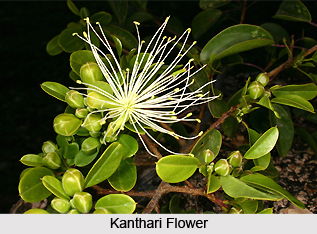 Kanthari is an indigene Indian medicinal plant, bearing the scientific synonym of Capparis sepiaria. Kanthari also is known commonly by its umpteen regional names, like: kaliakara in Bengali; kantharol in Gujarati; hiun and kanthari in Hindi; basingi, kadukatri, kathari gida, voile uppi gidda in Kannada; kanthar, mastondi, waghati in Marathi; hulubhi, kontoko, solorakoli in Oriya; hingerna, hins, hiungara, hius in Punjabi; karindu, karun-jurai, kattukkattiri, kokkimullu, shenkathari, thoratti in Tamil; and, nallapuyyi, nallavuppi, nalluppi, puyyi, uppi in Telugu.
Kanthari is an indigene Indian medicinal plant, bearing the scientific synonym of Capparis sepiaria. Kanthari also is known commonly by its umpteen regional names, like: kaliakara in Bengali; kantharol in Gujarati; hiun and kanthari in Hindi; basingi, kadukatri, kathari gida, voile uppi gidda in Kannada; kanthar, mastondi, waghati in Marathi; hulubhi, kontoko, solorakoli in Oriya; hingerna, hins, hiungara, hius in Punjabi; karindu, karun-jurai, kattukkattiri, kokkimullu, shenkathari, thoratti in Tamil; and, nallapuyyi, nallavuppi, nalluppi, puyyi, uppi in Telugu.
Kanthari is widely distributed in the country and is common in open scrublands throughout the dry regions of peninsular India and the Andaman Islands. The plant can also be seen to grow occasionally in northern India, that is sometimes grown as a hedge. Witnessed as a much-branched shrub or woody climber, Kanthari, the Indian medicinal plant grows up to 5 metres in height. The plant also appears curved with stipular spines that are 1 millimetre to 3 millimeters in length, with young shoots more or less pubescent. The leaves are placed at alternate intervals, which are again oblong-elliptic or obovate in shape, measuring within 2 centimetres to 6 centimetres in length and 0.5 centimetres to 3.5 centimetres in breadth. The apex of Kanthari`s leaves are rounded-obtuse or retuse, which are further acute at the base, obtuse or rounded, pubescent on both surfaces, with the upper surface appearing as glossy.
Flowers of this Indian medicinal plant are white in colour, measuring within 0.9 centimeter to 1.3 centimetres in diameter, borne in short-peduncled or sessile 8 to 18 flowered umbels. The pedicels measure within 1 to 2 centimetres in length, which are filiform in bare essentiality. The fruits or berries of Kanthari are fleshy, edible, globular in shape, measuring between 0.6 centimetre to 1.3 centimetres in diameter. The fruits are borne in clusters, that turn deep purple to black when ripe and pale brown when drying out. The medicinal plant flowers between the months of February and June, while the fruits mature during the rainy season between June to August.
The specified Indian medicinal plant is credited with febrifugal, alterative, tonic and antiseptic properties, which is further considered useful for treating skin diseases. A paste of the leaves is applied to relieve facial and other swellings following sunstroke among the Bhil tribesmen. A decoction of the Kanthari plant is useful for treating skin diseases. The juice of the inner bark of the root is used in the treatment of scabies and eczema. Adding further to the list of medicinal utilities for Kanthari herb, a paste of the crushed roots along with ginger and asafoetida is applied externally as a treatment for mumps amongst the Bhil and Nayaka tribes in northern Gujarat,. The Irulars of Tamil Nadu use the crushed root pulp as an external application to promote the healing of small wounds and scratches. In Maharashtra, the Agari and Bhil tribesmen use a decoction of the bark and the powdered root to cure gout and dropsy.



















